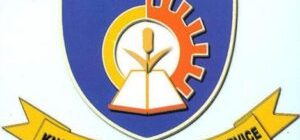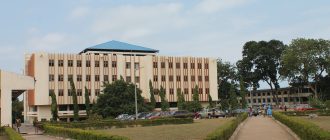Aeronautical Engineering At KNUST
About Aeronautical Engineering AtKNUST
- Program: (B. Sc.) Aerospace Engineering
- Degree Awarded: B. Sc.
- Duration: 4 Years
- Faculty: Faculty of Mechanical And Agricultural Engineering
- Academic Department: AEROSPACE
- Entry Requirement:WASSCE/SSSCE APPLICANTS Credits in THREE Core Subjects (English Language,Mathematicsand Integrated Science) plus THREE credits in the following Elective Subjects: Physics, Mathematics and Chemistry.
A’ LEVEL APPLICANTS
FIVE (5) credits at O’ Level including English and Mathematics, plus,EITHER
Passes at A’ Level in Pure Mathematics, Applied Mathematics and Physics with an O’ Level credit in Chemistry.OR
Passes at A’ Level in Mathematics, Physics and ChemistryMATURE APPLICANTS
Applicants must be 25 years at the time of submitting the Application.EITHER
Five credits at the O’ Level including English Language, Mathematics, Physics and Chemistry.
OR
WASSCE/SSSCE credits in THREE (3) Core Subjects (English Language, Mathematics and Integrated Science), plus credits in THREE (3) Elective Subjects (Mathematics, Physics and Chemistry).
Guide to Career in Aerospace Engineering
What is Aerospace Engineering? Aerospace engineering majors research, design, and develop high-speed transportation vehicles, such as: aircraft, spacecraft, missiles, space stations, and lunar vehicles.
Aerospace engineering majors deal in the analysis, synthesis, and design of aeronautical and aerospace vehicles. Students can specialize in either aeronautics (aircraft design) or aerospace (spacecraft design) at an undergraduate level. Depending on their concentrations, aerospace engineering majors enroll in different electives in each field.
A college degree in aerospace engineering combines engineering and management methods from related disciplines with the unique tradition of aerospacetechnology. Although very closely related to air transportation and design, aerospace technology is a little more intensive. Some aerospace programs emphasize hands-on training and subsystem design, whileothersrely more on lectures and fieldwork.
Currently in the United States, only a handful of institutions have earnedaccreditationto offer degrees in aerospace engineering.
What kinds of courses do aerospace engineers take?
The general academic program for aerospace engineers begins with two years of science and basic engineering coursework. After that, two more years of specialized courses allow students to hone their career paths. Specialized courses cover topics like:
propulsion,
structure,
thermodynamics,
controls, and
avionics.
What kinds of jobs can I expect as an aerospace engineer?
After earning their college degrees, aerospace engineering majors can choose from a wide array of careers, including positions in: research, design & development, management, field service,marketing&sales, software development, and teaching.
Institutions offer certificate and degrees in both two- and four-year programs. Educational and career aims vary from program to program, centered on the two main branches of aerospace engineering:
aircraft/missile issues, and
spacecraft/space systems issues.
Some institutions provide a curriculum that covers both areas. Other schools completely separate the two disciplines and offer degree programs in both aeronautics and aerospace engineering. A handful of universities offer only aeronautic or aerospace engineering.
The always-evolving field of aerospace engineering is one of the most challenging career paths in the world. Technology advances at a rate unparalleled since the Industrial Revolution. Aerospace engineers are at the forefront of that expansion.
When considering aneducationin aerospace engineering, prepare to encounter a significant amount of actual design and implementation in addition to coursework. Career choices are nearly limitless, since the entire aerospace field grows at such a rapid pace.
“I get to work on all kinds of projects that are in the news . . .”
One of NASA’s top female aerospace engineers took time to answer questions from students on the NASA website. She explains some of the benefits of her exciting career:
“My work is different every day, and changes from year to year. This is necessary for me since I get bored easily. The work is challenging (which keeps boredom away). You get to work on things that really make a difference to people; it might be a space instrument to measure atmospheric pollution or an improvement to an aircraft that might ultimately allow the price of an airline ticket to go down.
As a NASA aerospace engineer, I get to work on all kinds of projects that are in the news, like shuttle and space station, and everyone on my street wants to know about what I’m doing at work. It is really nice to work on things that people have an interest in, and to work on things that even kids think are interesting (no offense, but high school students are pretty tough critics!).”
– Jill Marlowe, Head of NASA’s Mechanical Design Branch
Traits of Successful Aerospace Engineers
College admissions counselors have also identified some extracurricular activities and personality traits shared by the most successful aerospace engineering majors. These interests include:
model aircraft and rocketry,
astronomy,
piloting,
space exploration,
computer games,
engine operation,
computer programming, and
general problem solving and people skills.
Career Education in Aerospace Engineering
To enter in a college degree program in aerospace engineering, the candidate must first possess a high school diploma or a GED. In addition, admissions officers review an applicant’s transcript to decide whether a student could be a successful aerospace engineering major. Many admissions counselors recommend the following high school course load: English – 4 Years Algebra – 1 Year Calculus – 1/2 Year Geometry – 1/2 Year Pre-calculus – 1 Year Trigonometry – 1/2 Year Biology – 1 Year Chemistry – 1 Year Physics – 1 Year Economics – 1/2 Year History of Social Studies – 2 Years Foreign Language – 2 Years Computer Science – 1/2 to 1 Year
Prospective aerospace engineering majors should take as many science courses as possible. Understanding foreign languages, especially German and Japanese, also paves the way for success in this global specialty.
Associate Degrees
Unlike other engineering specialties, which offer students the opportunity to qualify for apprentice positions by completing an associate degree program, the aerospace engineering industry encourages job seekers to enroll directly into a four-year bachelor’s degree program.
A handful of schools do offer associate degrees in aerospace engineering, but they reserve those positions for engineers who have completed degree programs in other fields. By allowing those engineers to catch up with their colleagues, associate degree programs offer career switchers the option of shifting their goals while maintaining the consistency ofeducationfor the benefit of public safety.
Bachelor’s Degrees
Most aerospace engineering majors earn their bachelor’s degree in four years. When entering into an aerospace engineering degree program, students should expect to enroll in a series of specialized classes. These classes will often include subjects like:
– statics
– dynamics
– structural analysis
– linear control systems
– propulsion systems
– vehicle design
– aerodynamics/fluid mechanics
– stability & control
– flight mechanics
– wind tunnel testing
– orbital mechanics
– spacecraft systems
– orientation & control
– telecommunications
– power & thermal control
Master’s Degrees
Professionals who already possess a bachelor’s degree can pursue the Master of Science in Aerospace Engineering. Aerospace engineering majors who transfer in from another career may be required to complete a series of undergraduate level prerequisites in order to qualify for the more rigorous graduate level courses.
Master’s level aerospace engineering majors can choose to specialize in one or more critical areas in their field. For example, many majors choose to focus on aerodynamics and propulsion, in order to prepare themselves for careers as engine designers. Students interested in pursing careers as aircraft or spacecraft designers can specialize in flight vehicle structures and materials. Meanwhile, prospective safety specialists can concentrate on flight dynamics, safety and controls.
Earning a master’s degree opens up a wealth of opportunities for experienced aerospace engineers. In addition to pursuing lucrative careers in the private sector, many master’s degree recipients serve asadvisorsor adjunct faculty at major universities and research institutions.
Doctorate Level Degrees
Experienced aerospace engineers who hold both a master’s and a bachelor’s degree in their specialty may choose to pursue the Ph.D. Doctorate level programs in engineering are extremely research intensive. Many doctorate candidates work on teams with veteranfaculty memberson highly innovative development programs in conjunction with the United States Government or with private industry.
Many of the innovations in aircraft design that we take for granted today started out as research projects for doctoral candidates. Once they earn their diplomas, these aerospace engineers not only share their passion for their field with future generations of students, they spearhead the next wave of groundbreaking design for tomorrow’s travelers.
Doctorate programs vary by length, depending on the specialty of the student and the amount of time they can devote to research. Online courses and other distance learning tools have opened up these programs significantly in the last few years. Many working professionals can participate in worldwide research programs by connecting over the Internet. Instead of working on design models in a studio, they can run simulations online.
Doctoral candidates can participate in advanced research opportunities by competing for fellowships at institutions nationwide. Fellows often enjoy significant benefits, like priority access to equipment like supercomputers and wind tunnels. They also benefit from close connections with the institutions that fund the fellowships, such as corporations or influential family foundations.
In order to retain qualified aerospace engineers, many major employers offer their staff members the ability to participate in tuition reimbursement programs that cover the cost of online learning programs. Some companies take this dedication to professional development even further by providing their engineers with space and resources to conduct research in house. The company benefits by retaining the rights to the discoveries, while the engineers benefit from an accelerated path to a higher degree and, ultimately, more income from salary and patent royalties.
What can you do with a University Degree in Aerospace Engineering?
Career options for aspiring aerospace engineers
Most positions in the field of aerospace engineering involve designing and developing flight-worthy aircraft. Your education level determines your eligibility for various types of job opportunities in the aerospace engineering field. The higher the level of education you attain, the more positions you may pursue, and the higher the salary you can expect.
For obvious reasons, most aerospace engineers pursue careers in the aerospace industry. This market segment encompasses many organizations such as aerospace prime contractors (and major suppliers), the propulsion industry, academia, NASA, the Department of Defense (and other government agencies) and the airlines. There are a great number of careers in these and other areas that apply to aerospace engineering majors. These include research and development, marketing, computer applications and more.
In order to have an effective career in the research and development industry, a master’s degree is recommended. In addition, organizations often offer financial aid to their employees seekinghigher education. A doctorate is usually reserved for individuals wishing to teach at a university level or in advanced research.
Not limited to aerospace engineering alone, students have used a bachelor’s degree in the field to go on to graduate degrees inmedicine, law, andbusiness. Following are a few of the different career paths available to aerospace engineering majors.
Commercial Aerospace Engineers – A quick check of any travel website will prove that the airlinebusinessremains one of America’s most competitive industries. With rising fuel costs and growing passenger demand for improved amenities, airlines rely on commercial aerospace engineers to develop innovative, efficient new forms of air travel.
Although many commercial aerospace engineers build aircraft that can stand the test of time, passengers constantly demand larger seats, more storage space, and constantly higher levels of comfort. Therefore, expert design firms invest significant resources into developing new aircraft that meet these needs while allowing for creative repurposing in the future.
For example, many new passenger jets can be refitted to handle cargo after they have outlived their usefulness for commercial airlines. Similarly, a new breed of planes allows owners to replace damaged or defective modules quickly and easily. Previous models required major overhauls to correct the mistakes of careless passengers.
Creative commercial aerospace engineers have also revolutionized the way we work and travel in America. By developing smaller, more efficient planes, a wave of discount and regional airlines has sprung up across the country. Because these planes cost much less to operate, carriers can charge lower fares while serving parts of the country that could previously only be reached by car or train.
Military Aerospace Engineers – Defending our borders requires the might of our armed forces and the knowledge of talented aerospace engineers. In a political climate where our country attempts to do more with less money, military aerospace engineers work hard to develop innovative new tools to combat our enemies effectively.
In recent years, military aerospace engineers have developed astonishing devices like remote control surveillance aircraft and laser guided weapons systems. Tools like these allow soldiers to fight wars with greater loss of life on both sides of a conflict.
Spacecraft Designers – Job opportunities in this field used to be limited to a handful of potential employers. But advances in technology and worldwide competitions like the recent X-Prize have revolutionized the space industry. More than ever before, private companies are making plans to send tourists, researchers, andbusinessprofessionals into space – even if the flights only last a few hours.
Companies like Virgin Atlantic and dozens of smaller countries just launching their own space exploration programs demand more qualified aerospace engineers to literally help their ideas get off the ground. Because of the tremendous risks involved, many spacecraft designers spend most of their time working on supercomputer simulations. This new technology significantly reduces expenses for their employers, while assuring the safety for a craft’s eventual passengers.
Engineering, Science and Data Processing Managers – As aerospace engineering has shifted most of its research and development to simulations running on supercomputers, a new breed of data processing managers has emerged to make these simulations more efficient and more effective. By analyzing data flow and deploying state of the art solutions, these specialists can help significantly reduce the amount of time it takes for a new product to reach customers.
In addition, many data processing managers serve as another fail-safe system in major manufacturing operations. They can monitor and report out on data that indicates problems with a project, and their background in aerospace engineering provides them the skill to participate in the search for effective solutions.
Data processing managers often rely on their strong interpersonal skills to supervise teams of developers and researchers. At the same time, they must effectively communicate test results and schedules to teams of designers, who often compete internally for access to resources.
Inspectors and Compliance Officers – The safety of passenger and people on the ground depends on the quality work of aerospace engineers and their teams. Therefore, many experienced aerospace engineers serve as inspectors and compliance officers, who enforce a wide range of laws, regulations, and policies.
Inspectors work for government safety boards as well as for private companies. In fact, aerospace manufacturers employ many in-house inspectors in order to prevent potential faults or violations before an official inspection takes place. A growing number of inspectors work as consultants for smaller companies who want to spread their innovation to the public, but have not yet grown the resources to maintain large, in-house compliance staffs.
Many inspectors travel frequently, in order to visit research and manufacturing sites around the world. Inspectors also participate in many conferences and professional development seminars designed to alert the aerospace engineering community to potential safety issues and other threats.
Mechanical Engineers – Mechanical engineers design, research, and develop tools, engines, and machines. These include many of the main and peripheral systems used in aerospace engineering. These systems can be as enormous as a rocket propulsion engine or as small as a warning sensor in a space shuttle.
Drafters – Drafters prepare the technical drawings and specification sheets that are used by production and manufacturing personnel to build spacecraft, aircraft, and more. These drawings encompass every facet of the craft and include views from all sides. Incredibly detailed, drafters are given the task of providing every specification needed for the proper construction of the craft.




